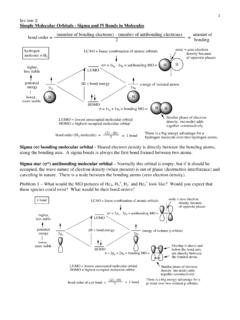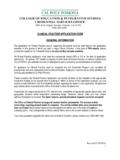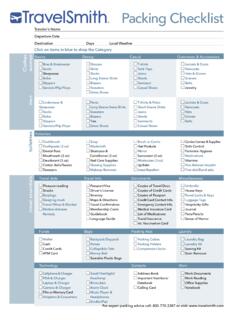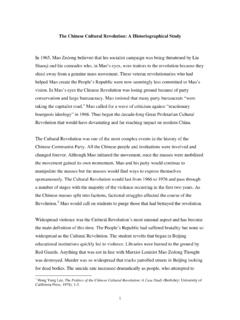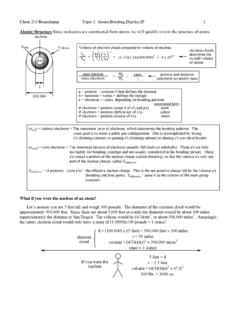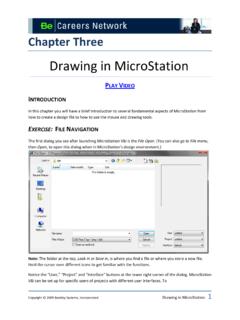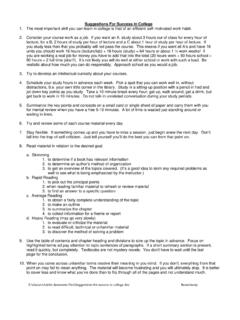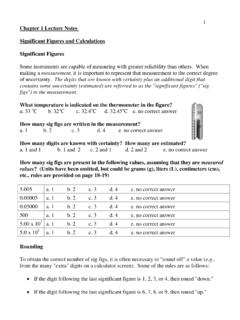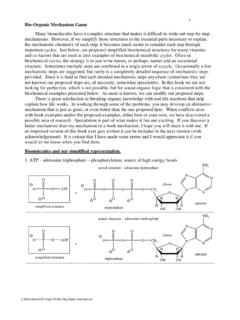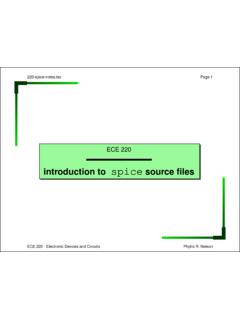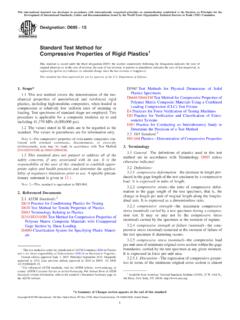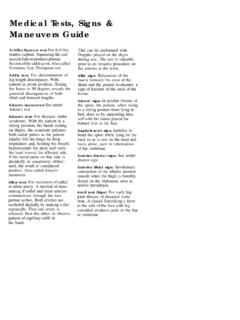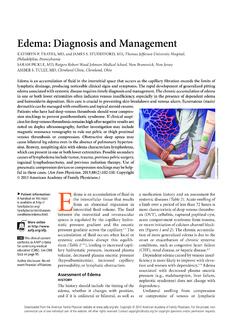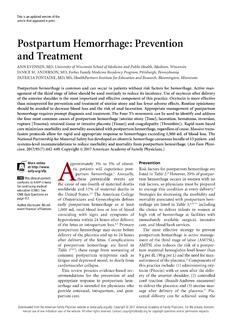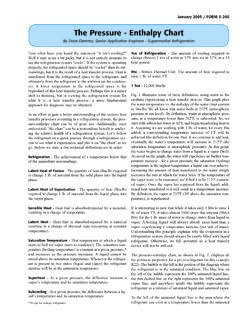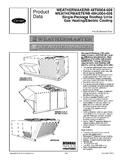Transcription of Exercises on Oscillations and Waves Exercise 1 - CPP
1 Exercises on Oscillations and WavesExercise find a spring in the laboratory. When you hang 100 grams at the end of the springit stretches 10 cm. You pull the 100 gram mass 6 cm from its equilibrium position andlet it go att= 0. Find an equation for the position of the mass as a function of first find the period of the Oscillations , then we can obtain an equation forthe motion. The periodT= 2 m/k. The massmis Kg. To findk, we use thefact that 100 grams causes the spring to stretch an additional 10 cm. SinceF=k x,we havemg=k ( ) =k( )k= period of the motion is thereforeT= 2 Att= 0 themass is at its maximum distance from the origin. Thus,x(t) = (2 t/T). UsingT= sec givesx(t) = (2 )x(t) ( )The cosine function is the appropriate one, since att= 0 the mass is at its maximumdistance from has two pendula, one has a length of 1 meter, and the other one is longer.
2 Shesets them both swinging at the same time. After the 1 meter pendulum has com-pleted 12 Oscillations , the longer one has only completed 11. How long is the longerpendulum?One can solve this problem by taking the ratio of the equation for the periods of thetwo pendula. Since the period of a pendulum (for small amplitudes) is approximatelyT= 2 l/g, we have1T1= 2 l1gT2= 2 l2gfor each of the pendula. Dividing these two equations we haveT1T2= l1l2(1)Solving forl2we havel2=l1(T2T1)2(2)Usingl1= 1meter, andT2/T1= 12/11 yieldsl2= 1(12/11)2 (3)So the longer pendulum is meters spring is hanging freely from the ceiling. You attach an object to the end of thespring and let the object go. It falls down a distance 49 cm and comes back up towhere it started.
3 It continues to oscillate in simple harmonic motion going up anddown a total distance of 49 cm from top to bottom. What is the period of the simpleharmonic motion?You might think that there is not enough information to solve the problem, butlets try and see if we need to know more about the system. Let the mass of the objectbemand the spring constant be labeledk. The period of simple harmonic motionfor an ideal spring is given byT= 2 mk(4)To solve for the periodT, we need to know the ratio ofm/k. What does the 49 cmtell us? This is the total distance from the top to the bottom of the simple harmonicmotion. Letd= 49cm. This means that the equilibrium position liesd/2 from the2top. This is the distance (d/2 cm) that the massmwould stretch the spring due toits weightmg.
4 In terms of the spring constant we havemg=k(d2)mk=d2gSubstituting into the equation for the period we haveT= 2 d2g 10 (5)sinced= 49 cm, and we have usedg= 980cm/s2. Looks like we had enough infor-mation after the system shown in the figure, which consists of a rod of lengthLand massMthat can spin around its center. There is a little hole in the center of the rod,which allows the rod to rotate, without friction, about its center. There is a spring,with spring constantk, attached to one end. The rod is pulled to one side and setfree to oscillate. Is the motion one of simple harmonic motion? What is the periodof oscillation. Express your answer in terms ofM,L, determine if the motion is simple harmonic, we need to see if the restoring forcefrom the equilibrium position isproportionalto the displacement from system is a rod that can rotate about its center.
5 The appropriate equation forrotation about a fixed axis isI = net(6)whereIis the rotational inertial about the axis of rotation, =d /dtis the angularacceleration about the axis, and netis the net torque about the axis. The rotationalinertial for a thin rod of massM, lengthL, that rotates about its center isML2 torque about an axis equals the force applied times the moment arm. In ourcase, if the angular displacements are small, the force is perpendicular to the torque is therefore given by =rF= (L/2)F, whereFis the force that thespring exerts on the end of the force the spring exerts on the rod equalsktimes the extension of the = 0 is the equilibrium position, then the spring exerts a force equal tok(L/2) ,where is the angle the rod is rotated from its equilibrium position.
6 Putting thepieces together, the equation of motion for the rod isI = net(ML212)d2 dt2= rF(ML212)d2 dt2= L2k(L 2)The minus sign is needed since the force is a restoring force. If is positive, theforce (and the torque) is in the negative direction. If is negative, the force is in thepositive direction. The spring always pushes or pulls the rod back to its equilibriumposition. Simplifying the equation above givesd2 dt2= 3kM (7)since theL s cancel. The solution to this equation is (t) =A sin( t), where = 3k/M. So the period of the motion isT= 2 / orT= 2 M3k(8) Exercise a spring that is standing on end in the vertical position. You place 100grams on the spring and it compresses a distance of ) If an additional 200 grams are placed on top of the 100 gram mass, how much willthe spring compress?
7 This is an easy question if we assume that the spring obeys Hooke s Law. If100 grams compresses the spring cm, then 200 grams will compress the spring2( ) = ) What is the spring constant?4 The spring constant is defined in the equationFx= kx. Consider the 100 grammass. It exerts a force ofF=mg= ( )( ) = the spring. Thecompression is , so the spring constant isk=Fx= 10N/m(9)You would get the same result if you considered the 200 gram mass and its massless spring attached to a wall lies on a frictionless table. It has a block of mass2 kg attached to one end. Initially the block is at rest. Another block, also of mass 2kg is sliding along on the tabletop with a speed of 8 m/s. At timet= 0, the movingblock collides with the block on the spring.
8 The two stick together and oscillate backand forth. If the spring constant is 16N/m, find an expressionx(t) which describesthe motion of the two blocks that are stuck there are no external forces during the collision, linear momentum is con-served. Letvfbe the final speed after the collision. thenfinal total momentum=initial total momentum(m1+m2)vf=m1v0(2 + 2)vf= 2(8)vf= 4m/sThis speed of 4 m/s is the initial speed for the oscillatory motion. Since the springobeys Hooke s law, the motion is one of simple harmonic ( sinusoidal) with = k/m= 16/4 = 2s 1. The general expression for simple harmonic motion is:x(t) =x0cos( t) +v0 sin( t)(10)For our example,x0= 0 since the blocks are atx= 0 att= 0. Thus only the sinterm is present:x(t) = 2sin(2t)meters(11)where t is in object of massmis oscillating back and forth in simple harmonic motion.
9 Themaximum distance from equilibrium isA, and the period of oscillation isT. Att= 0the object is at the origin,x= 0, and moving in the xdirection. Find the followingin terms ofm,T, andA:a) The equation of motion of the general form for the equation of motion isx(t) =x0cos( t) + (v0/ )sin our case,x0= 0. Since the maximum amplitude isA, we have|v0/ |=A. Sincethe object is initially moving in the - direction,v0<0 sov0/ = A. Since = (2 )/T, the equation of motion is therefore:x(t) = Asin(2 Tt)(12)b) The maximum speed of the find the velocity of the object for any timet, we can just differentiatex(t).Thus,v(t) =dxdtv(t) = A2 Tcos(2 Tt)using the chain rule. Since the cos function varies between 1 and +1, the maximumspeed is (2 A) ) The maximum acceleration of the find the acceleration of the object for any timet, we can just differentiatev(t):a(t) =dvdta(t) = (A2 T)2sin(2 Tt)using the chain rule again.
10 Since the sin function varies between 1 and +1, themaximum acceleration is ((2 A)/T) ) The total energy of the total energy of an object moving in simple harmonic motion equals its kineticenergy as it passes through the equilibrium position. This is true since atx= 0 theobject has no potential energy ( it is at a minimum) and all of its energy is in theform of kinetic energy. Thus, we haveEtot=m2v2max=m2(2 AT)2 Etot=2 2mA2T2 Note: all our answers for this problem apply to any type of simple harmonic answers don t only apply to a mass on a the U-shaped tube containing a fluid shown in the figure. The cross sec-tional area of the tube isA, and the total length of the tube isl. The fluid is pushedup on one side and released. The fluid sloshes back and forth in periodic motion(assuming there are no frictional forces).
